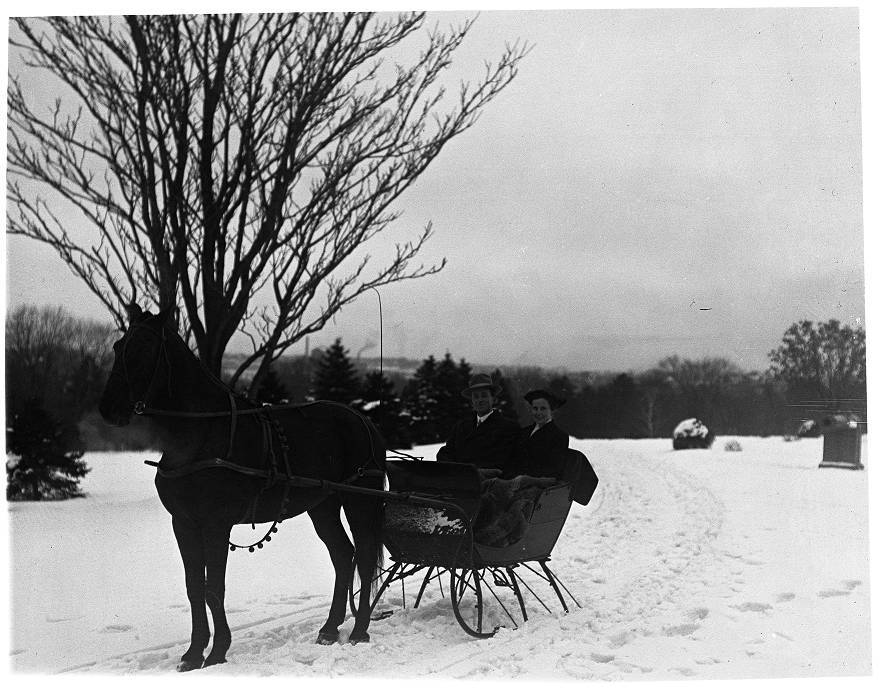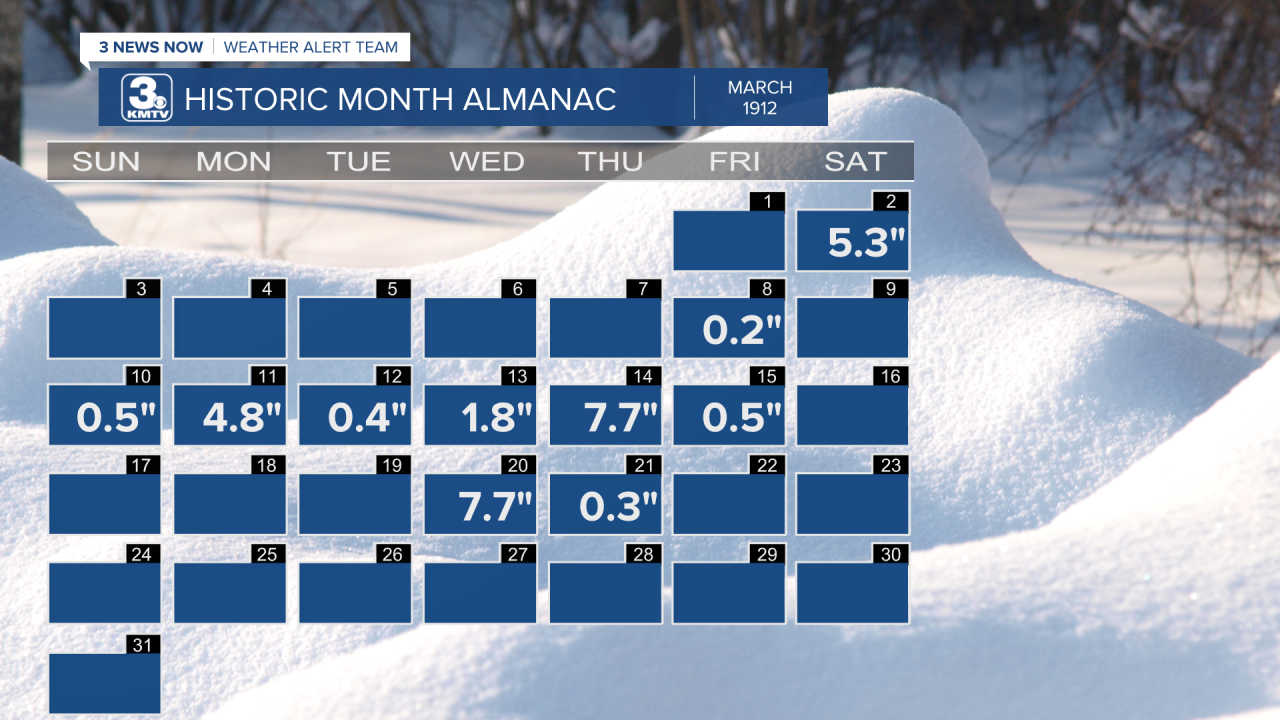Through previous installments of This Week in Weather History, we have detailed some of the worst winters that Nebraska and Iowa have seen through recorded history. From the true story behind the Little House on the Prairie book "The Long Winter", the winter of 1880-1881; to the brutal Nebraskan winter of 1948-1949; and finally, the back-to-back-to-back brutal winters of the later 1970s. We can add another winter to that list, the winter of 1911-1912, the snowiest winter in Omaha's history.
Using our 30-year average, Omaha receives on average 27" of snow from October to April. In that winter, Omaha saw triple that amount. Perhaps most surprising, half of the snow that entire year came in March, where 29.2" of snow fell over the month. Out of any month since snowfall data was kept in the 1880s, March 1912 remains the snowiest month in Omaha's history. In this installment of This Week in Weather History, we look at the meteorology and the impacts behind this historic winter.

THE "BLUE NORTHER" OF NOVEMBER 11, 1911
Winter arrived in a big way on November 11, 1911, it arrived on the heels of one of the strongest cold fronts in United States history. The "blue norther of 1911" as it's called today, did not bring as much of an impact in Nebraska or Iowa as it did farther southeast. High temperatures in Omaha and Des Moines reached the 40s, and lows that night fell into the single digits. Those who walked outside at 6 am saw temperatures in the 30s and had dropped into the teens by noon. By the next morning, a dusting of snow fell across Omaha.
In Missouri, the full force of the blue norther was felt. Temperatures in Kansas City hit 76, St. Louis 78, and Springfield 80. In the afternoon, the cold front came through and sharply dropped temperatures along with a howling northern wind. In Kansas City, the record high of 76 was sliced as temperatures dropped 13 degrees in 15 minutes. By the next morning, it was 11 degrees. The cold front also brought thunderstorms, which caused damage in Springfield as temperatures plunged from 80 degrees to 13 by the next morning.

To the east, the blue norther brought a significant tornado outbreak to parts of the Midwest. An estimated F-4 struck the town of Janesville, Wisconsin, followed by blizzard conditions only a few hours later. Other tornadoes hit Illinois, Indiana, and Michigan. The cold front and its associated temperature swing remain one of the most dramatic in US history, only seeing distant echos in the cold front that dropped the temperature in Omaha from 80 to 7 in 48 hours in February of 2024.
DECEMBER 1911
The rest of November after the blue norther was relatively calm for Omaha. Temperatures were cold, with the average temperature being 13.7 colder than the typical November temperature. On November 18, 1.8" of snow fell in Omaha, which combined with the 0.4" back on the 11th and a few more trace snowstorms brought 2.8" for November, around 1" above the average snowfall.
December 1911 was still calm temperature-wise, with Omaha landing around 1 degree above the December average. However, the snow began to fall during the month. December saw 14.8" of snowfall in Omaha, which is well above the average of 5.8". Most of the snow came in two bigger snowstorms, one on December 20-21, and the other on December 26.

6.6" of snow fell in Omaha from December 20-21, followed by 5" on December 26, making it 11.1" for the week. In a world before automobile use became widespread, the snowfall did not affect lives as much as it would today. Many businesses were still open, and those who went Christmas shopping did so. Where the snow did affect was trains, but the snowfall was light enough that the trains became snow plows on their own. People went to Churches to celebrate Christmas 1911, as most of the snow had fallen by that point. Only a trace remained around for Christmas Day, then more snow fell the next day.
JANUARY 1912
It was a relatively snowless January, with only 2.9" of snow falling for the whole month in Omaha. What January 1912 made up for in lack of snow was the cold. The average temperature for the month was just 10.8 degrees, the 8th coldest January on record. From December 29 to January 15, the low temperature in Omaha was below zero for 18 consecutive nights, the second longest streak (the longest was in 1936, see this post for more). The coldest temperature of the month was on the morning of January 12, when Omaha dropped to -27 degrees!

It was cold across the nation, with the Great Lakes experiencing their coldest January's on record. It was so cold that citrus crops in California were decimated, and Niagra Falls completely froze over!
FEBRUARY 1912
The cold weather continued in February but was not as cold as in January. Likewise, the snowfall ramped up significantly for February with over 18" of snow for the month where 7-8" of snow is more typical. In the first few days of the month, 4" of snow fell in Omaha, which caused minor issues with train and streetcar travel. Then on February 13, 3.5" of snow fell.
By far, the biggest snowfall in February was a "near-blizzard" that swept through the area and dropped 11" of snow in Omaha. In the city, not only was the train service severely disrupted, but so was the streetcar service. As automobiles were not widely used, many used the streetcar system. During the snowstorm, many streetcars became stuck in the snow, leading people to walk to their destinations. As it was a Sunday, those who went to the theater or other entertainment sometimes found themselves trapped as they could not get home.

The snowfall was larger just south of Omaha, where up to 2 feet of snow fell in cities like Nebraska City and Shenandoah. In those locales, the city effectively froze as some people could not even get their doors open to leave. Train service was completely stalled over Iowa, southeast Nebraska, and Missouri for many hours at a time. It was quite the snowstorm, but it wouldn't hold a candle to what March would bring.
MARCH 1912
If people were tired of winter and looking forward to spring, they were to be sorely disappointed. First, March was still cold, it would be the 4th coldest March in Omaha history. However, the big story was the snowfall. Officially, Omaha picked up 29.2" of snow, which is more than we typically see in a season! It is not only the snowiest March on record but the snowiest month on record in Omaha's history.

The snow fell in three big waves, the first wave came in the first few days of the month when about 5" of snow fell, but it caused little problems.

The second wave came between March 10 and 15, when it snowed for five days straight. By the end of the week, Omaha picked up over 15" of snow, with amounts approaching 2 feet along the Platte River valley.

Streetcar service was stopped in both Lincoln and Omaha as snow drifts over 5 feet high blocked them in. Except for a few larger trains, most railroad service was unable to move by the end of the week. School closed early on the final day, when the most snow fell, and children were greeted with a longer weekend. It took several days before life got moving again in Nebraska and Iowa.


Just as life got back to normal, another big snowstorm on March 20 swept through the region. Train services which just started back up were halted once more as over 7" of snow fell in Omaha. Further north, amounts close to a foot in cities like Norfolk brought the town to a standstill. For the people of Nebraska and Iowa, it felt as if winter would never end. The amount of snow that fell in March was incredible, and shattered many records. For Nebraska and Iowa, the snow was done for the winter, but Missouri had one more gut punch to endure.


Two days after the big snow on March 20, another round of heavy snow moved through Kansas and Missouri. In Kansas City, nearly 25" of snow fell to break the largest snowfall record in the city. St. Louis picked up over a foot, and other spots in Missouri saw close to two feet. It remains one of the largest snowstorms in Missouri history, on top of one of the snowiest winters for the state.

By April 1912, spring came quickly and much of the snow melted away, and soon the winter of 1911-1912 became a prominent memory for those who lived through it.




